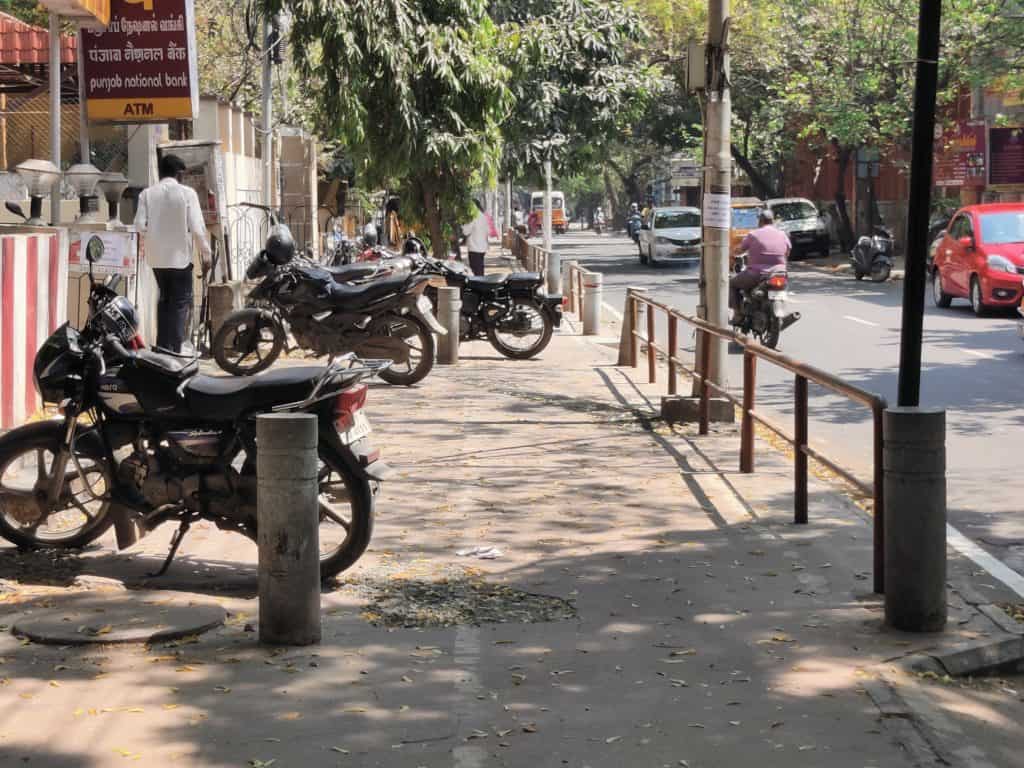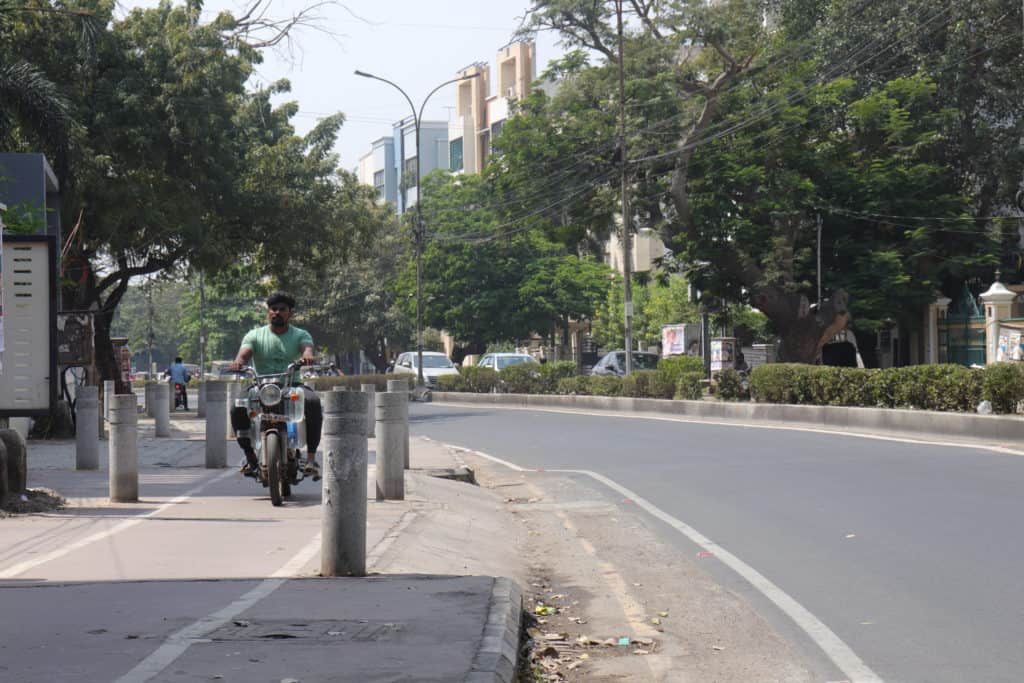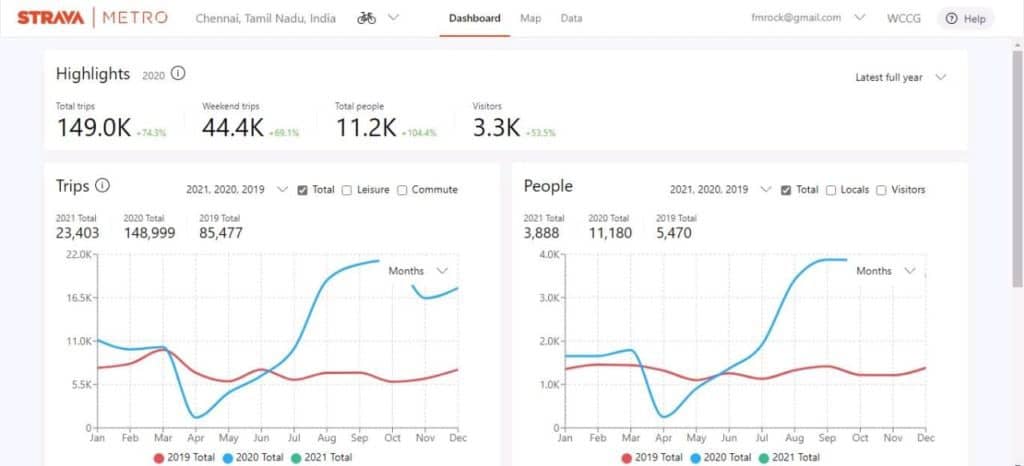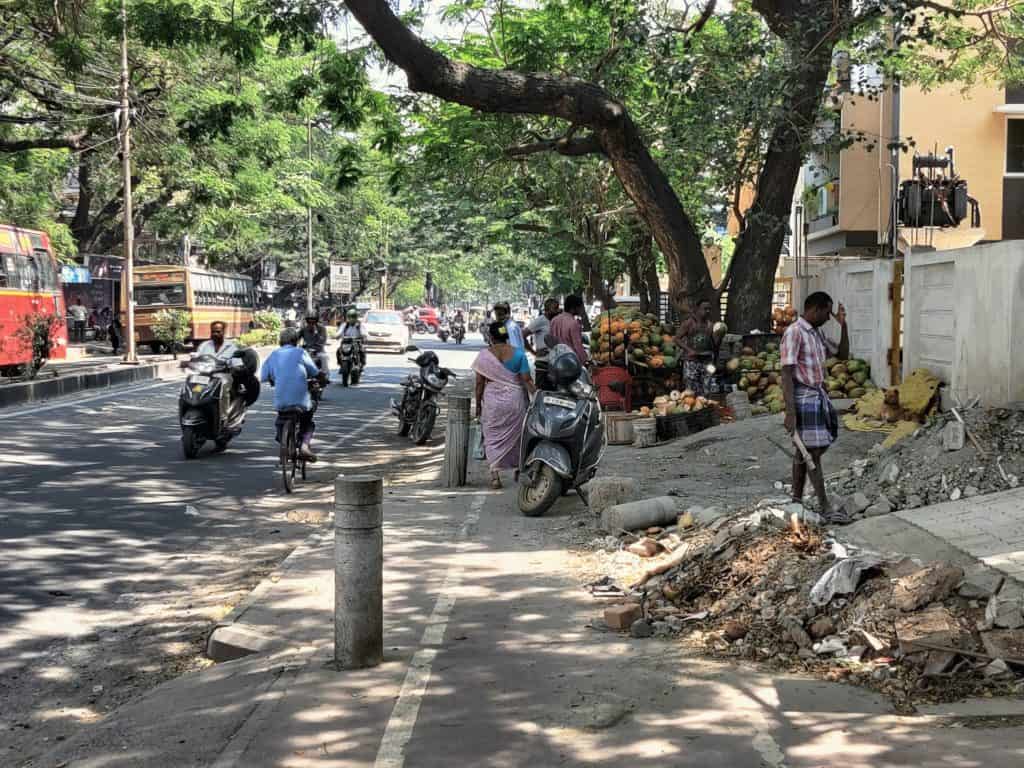K K Nagar cycle track, the first dedicated space for non-motorised transport (NMT) users in Chennai was laid three years ago. Today, the track is just a pothole-filled road with several encroachments.
The 17.5-km stretch from Sardar Patel Road to Island Ground is a demarcated cycle lane. But the lane gets narrower as one progresses and is even missing at a few places, leaving cyclists with no choice but to disembark and walk their cycles.
Greater Chennai Traffic Police has also set up a temporary pop-up cycling lane at Kamarajar Salai, meant to be operational for two hours every morning. But, here too, one can see two-wheelers and cars encroaching the space meant only for cyclists.
Trials of inconvenience
Chennai’s first-ever cycle track in K K Nagar induced a sense of pride and motivation among the residents, who consciously cultivated a hobby of cycling during the early days of the track. Young and old, housewives and college goers, fitness freaks and amateur cyclists — people from all walks pedalled on the newly-laid, wide tracks of K K Nagar.
Chinnamma P, a K K Nagar resident earns a living by supplying tea and snacks to the offices in Ashok Nagar and Ekkaduthangal. Her 10-year-old cycle is Chinnamma’s most convenient means of transport. “I pedal around 6 km one way. Cycling at the track (at K K Nagar) felt safe, without the fear of getting hit by a bike or a car,” she says. Of her 6-km route, 3.8 km falls on the track that snakes through the three main roads of PT Rajan Road, Ramaswamy Salai and Lakshmanaswamy Salai.
However, Chinnamma no longer cycles on the track, for it is now in worse condition than the main Road. With potholes and patches, callous parking of vehicles and push carts by street vendors, the track — a pet project of the Greater Chennai Corporation (GCC) — is almost unusable. Except for a few walkers during evenings, the track has been abandoned by everyone. “I only get a back pain if I cycle on that track,” sighed Chinnamma.
K K Nagar may have fared the the worst in terms of providing cycle-friendly infrastructure but despite being marginally better, other cycle lanes of Chennai also need definite improvement.
What deters cyclists?
There has been a considerable spike in the number of people cycling on Chennai roads, especially after the lockdown in 2020. “The change is evident. The empty roads of the city prompted many to take up cycling, to work and even as a hobby. A lot of those who started it as a hobby want to continue with it as a habit, though the roads are now congested again,” said T Karunakaran, a cyclist.
There is also a significant percentage of cyclists who quit because of the poor infrastructure in the city. According to a survey conducted by GCC and Chennai Smart City Limited (CSCL), 44% of women and 49% of men felt that pedestrians and parked vehicles are the biggest barriers to comfortable cycling in the city. Traffic congestion was a demotivating factor for 56% of women and 58% of men.
Here is another interesting statistic: 85% of women and 88% of men in Chennai prefer to own a cycle. These numbers, combined with the above, underline the fact that there are many passionate and budding cyclists in the city but the absence of cycle-friendly infrastructure puts them off.
Read more: Charts that show the revival of cycling in Chennai during the pandemic
Of the many infrastructure projects meant for cyclists in Chennai, barely one or two are a hit. The pedestrian plaza at Pondy Bazaar is one such example. Even though the facility is meant for pedestrians, cyclists use the wide, well-lit plaza in the evenings.
“With shoppers crowding the plaza and bollards installed here and there, I still wouldn’t call it the best. But it is way better than pedalling amidst the honking and aggressive cars and bikes,” said Shahul Hameed, who cycles at the plaza.
Why do the projects fail?
“Law cannot reach where enforcement will not follow,” writes popular fiction writer, Jack Vance. The quote is most apt in the given context.
It took not more than a month for KK Nagar cycle track to start manifesting signs of degradation. Blame it largely on lack of enforcement and proper planning. Departments including the Electricity Board dug up the road, after the track was opened up for use. “It is nothing but sheer lack of planning. There is no coordination between various government departments,” said Selvaraj K, advisor of 4th sector unit of Exnora, K K Nagar.
For better enforcement of such projects, it is important for the nodal agencies to team up with other departments. “Nodal agencies should not permit other departments to take up any civic works on the cycling lanes or tracks. Ideally, these works in K K Nagar should have been completed before the inauguration of the track,” said Rajendran, President, Sector 1.
Lack of continuity is another major hurdle. For example, at Anna Salai — the highways-maintained road infamous for long traffic queues and never-ending flow of vehicles — the cycle lane is just not marked or demarcated. “Even though the project boasts of creating a 17.5 km-long track, it’s just not possible for cyclists to take the entire stretch due to the risks involved. Who would want to risk cycling on Anna Salai?” questions Kalyanaram Sundar, an ardent cyclist. As most cyclists point out, the very purpose of a cycling track is defeated when the lanes do not have continuous stretches.
Many cycling projects in Chennai are currently taken up under Area Based Development of the Smart City Mission as opposed to pan city development, which, according to the strategies of the Mission, envisages application of selected Smart Solutions to the existing city-wide infrastructure. “When the existing infrastructure in areas are already in such condition, pan city development is a far-fetched dream,” says Felix John, Chennai’s Bicycle Mayor.
“We don’t have a segregated network in our cities that is useful enough to make people use it. Trying to build small pieces here and there doesn’t show commitment to the cause of sustainable mobility, it only harms it. For authorities, completing useful cycling networks at scale and sticking to it for a decade is the only way to go,”
Sathya Sankaran, a sustainable transport activist and Bengaluru’s Bicycle Mayor
A complex problem
Will the infrastructure improve when there are more cyclists? Or will there be more cyclists if the infrastructure gets better? The eternal chicken and egg problem.
Among Indian cities, Chandigarh seems to be setting a good example. The city has involved multiple government agencies and communities to encourage and preserve the habit of cycling on one hand and develop infrastructure on the other.
Infrastructurally, the city has been designed beautifully for cyclists. “Innovative measures have been taken up by the city of Chandigarh to raise awareness amongst motor vehicle users and cyclists in the city. Through good online and offline communication tools, the local body and the traffic police of Chandigarh have been able to bring about better enforcement in the city,” said Venugopal A V, Senior Research Associate for Urban Development, ITDP.
Suggesting that Chennai can also increase the initiatives taken to raise awareness on cycling through online and offline tools, Venugopal said that educating road users is very important for effective enforcement.
“If only the students at K K Nagar were sensitised to take up cycling, the track would have seen more takers. It would then become the responsibility of the community to protect the infrastructure,” Felix John said.
Looking at solutions
A variety of interventions from government agencies could motivate Chennaiites to switch to cycles for commute and leisure. Chennai should follow the Amsterdam example in introducing cycle-friendly infrastructure, cultivating cyclists and involving communities, say experts.
“The best example is Netherlands. The scale of continued interventions in provisioning bicycling facilities is something to emulate. They have shown that prioritising cyclists and staying the course will fetch returns over the long term,” says Sathya Sankaran.
“To take Amsterdam as an example is highly ambitious. It might not be practically feasible due to a multitude of factors,” says a GCC official, not willing to elaborate on the factors.
GCC projects the mega streets project as a solution to add cycle-friendly infrastructure in Chennai. “It is very important to have an integrated network of cycling infrastructure and the Chennai Mega Streets Programme is a step towards the right direction to ensure safe walking & cycling infrastructure in the city,” said Venugopal.
He further shared that there will be an integrated network for cyclists and parking management in the mega streets project. Six national design consultants are in the process of developing contextual design solutions to ensure good infrastructure for NMT users.
Unless the focus is shifted to proper enforcement, infrastructure projects for cyclists will only amount to a damp squib. After all, there have been several announcements or launches of cycle-friendly infrastructure in Chennai. What is missing is sustained follow-up, maintenance and enforcement of rules.
Also Read:




enforcement is issue need to be addressed by Government authority & civil society. Failure is due to both. Both bound to suffer
In Ramasamy salai Ravi travel cars are the major encroaching people. One way rule is not enforced in Ramasamy salai and Lakshmanasami salai
Yessss. Even the ,” footpaths are for walking” is TOTALLY ignored. There is NO need to plant trees in these footpaths. We all are used to walking since ages. Those who go abroad walk in every city for various reasons. Here also many of us are willing and wanting to walk to do small shopping or visit friends. But no footpath without obstruction. They are digging up good footpaths and roads to REDO!!we are NOT consulted. Just because they re elected, they make hay
I live in Lakshmanasamy road k k nagar.after demarcation of cycle tracks and the roads become narrow.The authorities ,rightfully,made the roads oneway but the enforcement authorities never bothered to implement/monitor.made online complaints also….no use.
It is dangerous now to use the two way narrow road specially for the visitors to park their vehicles while visiting people living here.
Unless proper enforcement is practised by the relevant authorities, these efforts will not be successful